Tested: 2023 Aston Martin DBX 707 Is More Than Just a Pretty Face
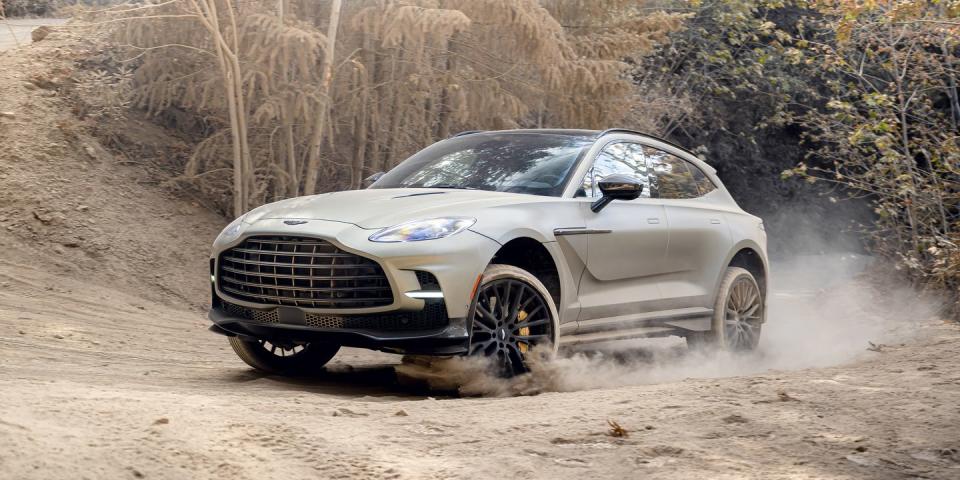
UPDATE 9/12/22: This review has been updated with test results.
Sports-car companies creating SUVs is a phenomenon enthusiasts have watched with varying degrees of horror, excitement, and acceptance ever since the Porsche Cayenne debuted. With its DBX, Aston Martin arguably—and, well, surprisingly—has been the most successful in transferring the design language of its sports cars onto an SUV shape. The brand, however, has also come to realize that the waning days of internal combustion are no time to hold back when it comes to horsepower. So, whereas the standard DBX develops 542 horsepower from its AMG-supplied twin-turbo 4.0-liter V-8, the new DBX 707 model produces 697 horsepower—or 707 PS in the more flattering European measure.
The design of this high-test version, of course, has been tweaked, mostly for reasons of function. The 707's grille opening is 27 percent larger to permit greater airflow for engine cooling. Flanking it are revised air intakes bisected by horizontal DRL lighting elements. There are several new aero bits: a carbon-fiber front splitter, revised skirts along the rocker panels, air deflectors ahead of the front and rear wheel openings, an air outlet cut into the rear quarter panels, an extended rear diffuser, and a longer rear spoiler. The mirror caps and side strakes can be done in carbon fiber or black to match the window surrounds, hood vents, and roof rails. Fortunately, none of these addenda detract too much from the organic shape of the DBX—although we're not particular fans of the rear air outlets and that protruding diffuser. Still, this is a long way from Mansory-style aftermarket overkill.
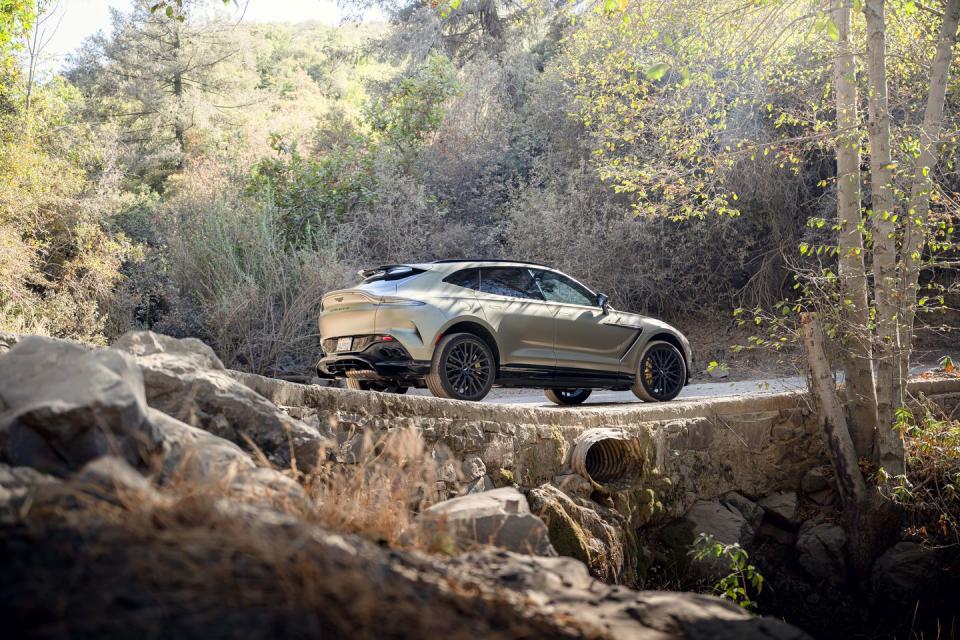
The uprated power output comes from the same 4.0-liter V-8 as the standard DBX. Of course, the engine isn't exactly the same: There a new turbochargers, redesigned induction and exhaust systems, and a reprogrammed engine control unit to manage it all. The massaging was done at Aston Martin under head of powertrain engineering Ralph Illenberger, who, having come from AMG, knows this engine well. To cope with the extra output, the standard DBX's nine-speed automatic transmission is replaced by an AMG-sourced version that features a wet clutch pack in place of a torque converter.
In addition to faster shift times, the new gearbox adds a Race Start launch-control function. It's easy enough to access. In either Sport or Sport+ mode, depress the brake and accelerator simultaneously. The digital instrument display flashes a red Race Start message, and when the revs hit 4000 rpm, release the brake and enjoy being launched back into your seat. We mean that quite literally—our passenger was leaning forward balancing a phone atop the dash to capture the moment, and the accelerative force flung him rearward into his chair, resulting in a video clip of the headliner instead.
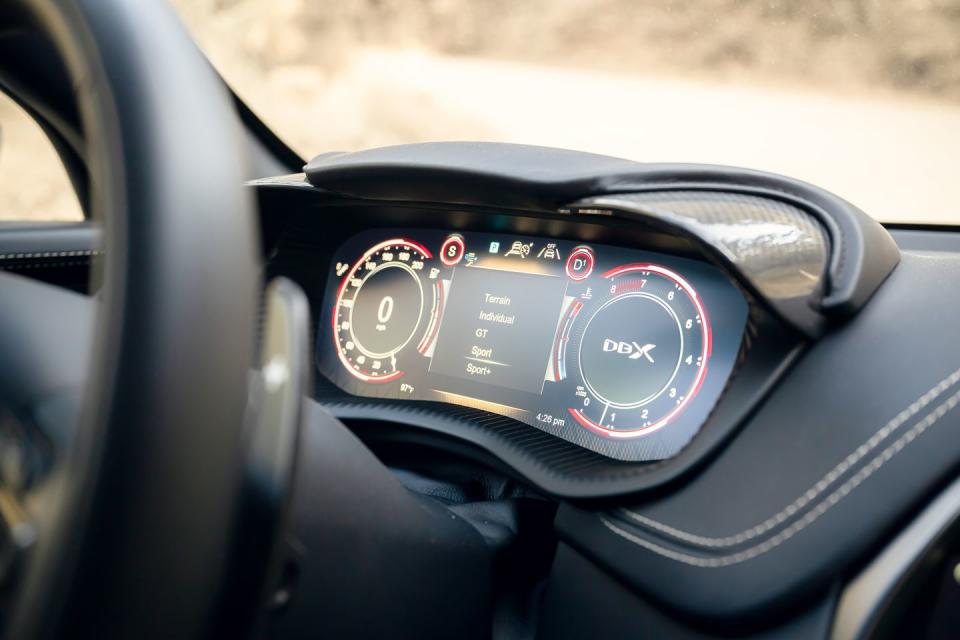
In our testing of the standard DBX, it vaulted to 60 mph in 3.9 seconds and dispatched the quarter-mile in 12.4 seconds at 114 mph. That doesn't sound too shabby, until you learn that those numbers trail the Audi RS Q8, the Bentley Bentayga V-8, the Mercedes-AMG GLE63 S, and even the Maserati Levante Trofeo. Bragging rights count, and the more muscular DBX 707—which also benefits from a shorter 3.27:1 final-drive ratio—chops the benchmark 60-mph time to 3.1 seconds and can reach 100 mph in 7.9 seconds. It also ripped through the quarter-mile in 11.5 seconds at 119 mph. Top speed is a claimed 193 mph.
In the real world—which for our drive was the island of Sardinia—the DBX 707 is simply insanely quick. You're hard-pressed to find an opportunity to fully stretch its legs for more than a few seconds at a time. When you do, the accelerative thrust is so intense that even the fractional pause in power during the transmission's extra-quick upshifts creates a head-bobbing moment as the DBX 707 rockets ahead.
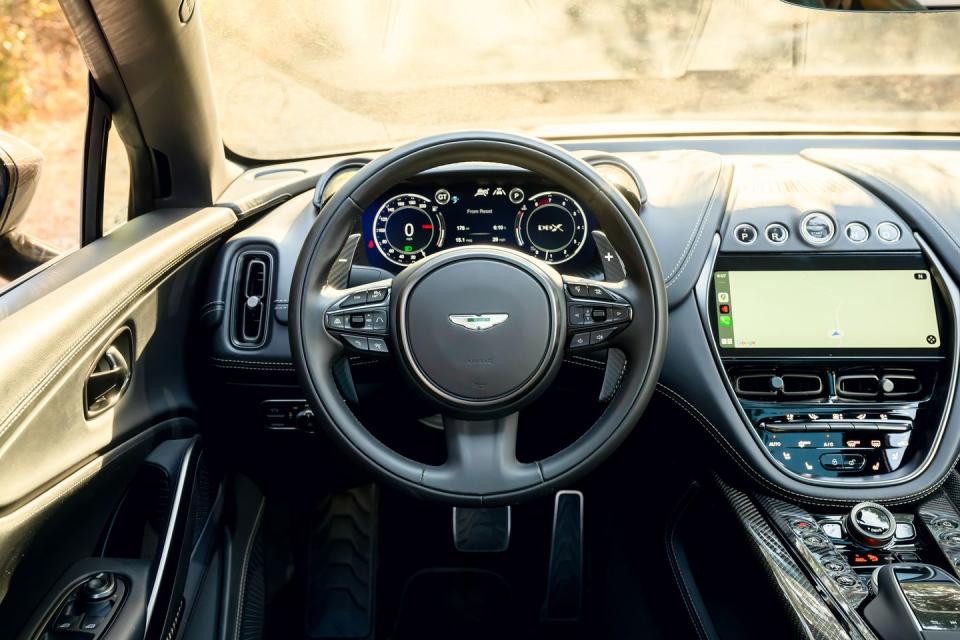
The 707's throaty soundtrack comes from an active exhaust system with quad outlets that's different from both the standard and optional sport setups in the base car. No matter the drive mode, holding either of the shift paddles when pressing the ignition button triggers a vocal, throat-clearing startup bark. Even in the mellower GT setting, and slightly more so in either of the two Sport modes, there's a spitting exhaust sound during upshifts, and the V-8 roars with a deep-voiced baritone as the revs climb—we recorded a vocal 84 decibels at wide-open throttle. But this Aston's soundtrack is still more reserved than the sharp crack of AMG's most hardcore products or the theatrical pops Jaguar favors.
Keeping a leash on all of that newfound power are new standard carbon-ceramic brakes exclusive to the 707. The rotors are a massive 16.5 inches across in front and 15.4 inches in back, gripped by black-painted calipers (or choose bronze, orange, yellow, red, or gray paint). The big stoppers are said to shed 88 pounds compared with the cast-iron rotors in the standard DBX. We groused that in the regular car, the brake pedal is less responsive than we'd like in its initial bit of travel, but we had no issue with modulation here. The carbon-ceramic brakes also erased six feet from the 70-mph stopping distance, bringing the DBX 707 to a halt in 151 feet. However, once the brakes warmed up, some squealing accompanied light applications—an issue Aston engineers say they're working on.
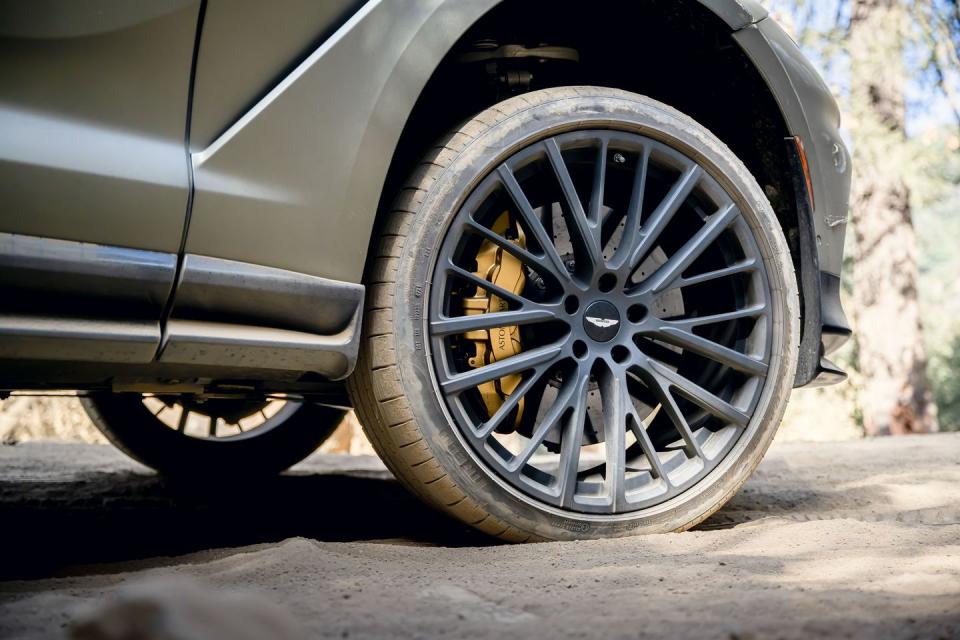
The 707 has four on-road drive modes and one for off-road, with selection done via a new dial on the console, making them relatively easy to access without taking your eyes off the road. Punch the center of the dial to call up the transmission's Manual mode, which holds your paddle-selected gears. We found Manual mode to be the preferred setup for attacking the long series of tight corners on the island's rural, mountainous terrain. With the full measure of this DBX 707's bountiful 663 pound-feet of torque available across a broad 2600-to-4500-rpm rev range, there just isn't much need to downshift into most corners or upshift coming out.
As in the standard DBX, this uprated model utilizes 48-volt active anti-roll bars along with air springs, which can raise the ride height by 1.8 inches or lower it by 1.2 inches. The system offers GT (default), Sport, and Sport+ modes. The active anti-roll system has been tweaked for increased roll resistance, and the cornering attitude is virtually flat. The ride, though, has become quite firm, although some of that harshness could be down to our sample car's 23-inch wheels (optional on both models).
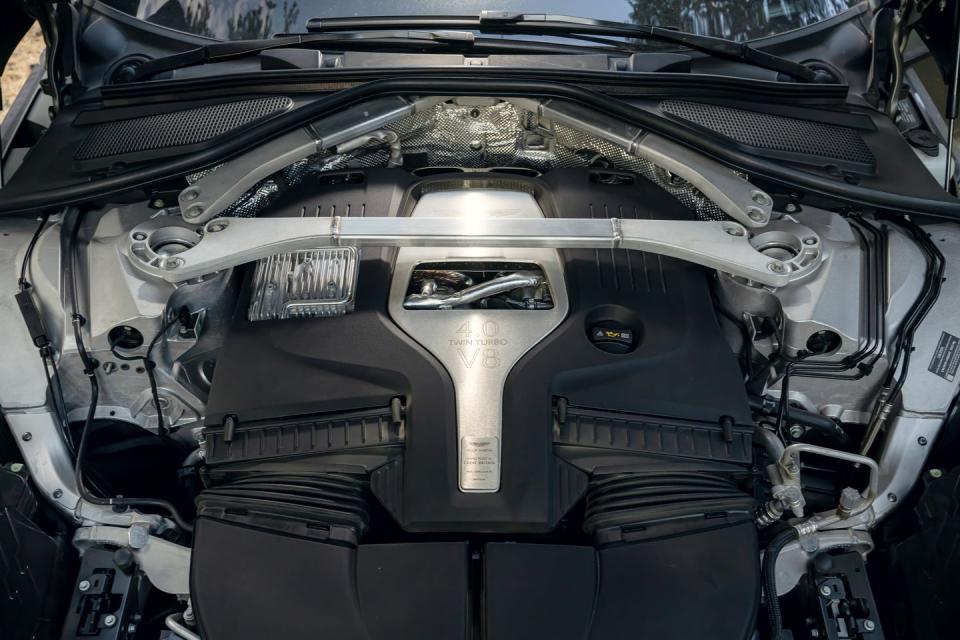
In an earlier drive of a pre-production DBX 707 at a racetrack in England, we experienced this enhanced SUV's amusing ability to power-oversteer. On public roads edged by steep drop-offs, we were more content to learn that the DBX 707 has grip for days. Some credit must go to the ultrawide Pirelli P Zero summer tires, sized 285/35ZR-23 up front and 325/30ZR-23 at the rear. But the 707's rear track also has been widened by 0.6 inch and its electronically controlled rear differential recalibrated, both of which help the rear end to better dig into the pavement when powering out of corners. On the skidpad, we measured 0.94 g of stick versus the base car's 0.92 g. The DBX 707 has surprisingly good balance for a heavy SUV, its rather light helm corresponding to an eagerness to change direction without a lot of push from the front end. This behavior is aided by a front-to-rear weight distribution of 53/47 percent, which is more advantageous than most of its competitors.
For less frenetic moments, there are the now-commonplace driver assists such as adaptive cruise control, lane-keeping assist, forward-collision warning, and blind-spot monitoring. The DBX, however, does not offer a hands-free driving aid—this remains a car for drivers who prefer to keep two hands on the wheel. As in the standard DBX, the environment for doing so is a rich, leather-everywhere cabin, and slipping inside is like stepping into the world's finest shoe store. Hides cover virtually every surface, and their fragrance fills the nostrils, reminding us that the greatest challenge facing "vegan leather" is the olfactory one. The 707's firmly padded sport seats have a different stitching pattern than in the standard car, with contrast-color elements around the shoulder area and a center stripe on the backrest.
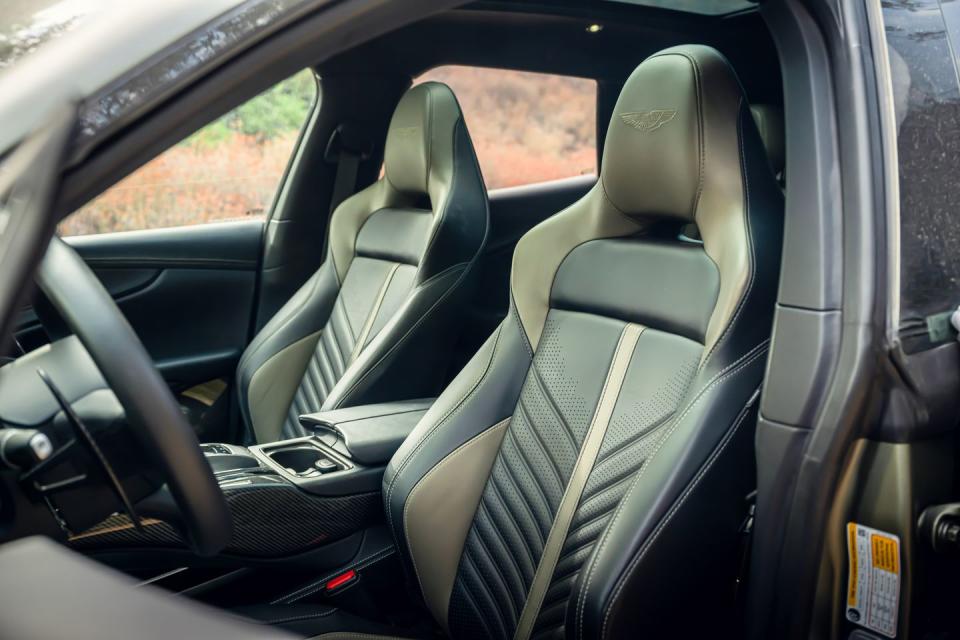
Like the engine, the infotainment system is another piece of hardware borrowed from the gang in Stuttgart, but it's not Benz's latest megascreen setup. Instead, it's a 10.3-inch display (with Aston's own graphics) operated via Mercedes's previous-generation rotary controller and touchpad. While we appreciate that layout for its tactility, the lack of touchscreen operation seems out of place nowadays, and it would be nice if the display could simultaneously show multiple functions, such as audio and navigation. The 707 also sports a revised center-console layout. Besides the aforementioned drive-mode selector, there are dedicated buttons to adjust the damper firmness and the exhaust note and switch off the engine's auto stop-start function. Both DBX models share enlarged cupholders as well as soft-close doors. And as in all Astons, gear selection is via a series of buttons in the center of the dash.
We can't say that the standard DBX was wanting for power, but the 707 certainly cranks up the intensity of its driving experience. It also, naturally, dials up the price. The ask here is $239,086 to start—some $50,000 more than the standard version. Nonetheless, Aston Martin expects the 707 to be the more popular DBX variant. Though the standard DBX continues to boast a supremely elegant design, in this market segment, nothing succeeds like excess.

You Might Also Like

 Yahoo Autos
Yahoo Autos 